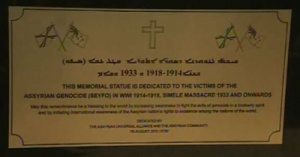“Who, after all, speaks, today, of the extermination of Armenians?” asked Adolf Hitler in 1939. But, then as now, even less speak of the genocide of the Assyrians – the torchbearers of the earliest civilisation – who fell victim to the same maniacal plan for the elimination of non-Muslims culminating in the massacre of hundred of thousands of Armenians and Greeks. The genocide of the Assyrians has yet to be officially recognised by any country, but the survivors have chosen this day – August 7th – to commemorate the tens of thousands of Assyrians systematically slaughtered by the Ottoman Turkish army during and after World War One because of their ethnicity and faith. Today also marks the beginning of the Simele Massacre in 1933, in which some 3000 Assyrians were brutally annihilated by the Iraqi Army only a year after Iraq declared its independence.
The Assyrians – whose roots date back to the mid-4th millennium B.C. – are the indigenous people of Upper Mesopotamia. Today that area straddles Iraq, Iran and Turkey. Not an easy place for a nationless Christian minority. At the conclusion of WW1, land had been promised by the British government in return for support from the legendary Assyrian fighters, but the game-playing imperialists never delivered. Instead, the British exploited ethnic and religious divisions in the region for their own gain – primarily oil fields and railways – and recommended Iraq be admitted to the League of Nations. After the establishment of the Kingdom of Iraq in 1932, the Assyrians refused to sign a declaration of loyalty to King Faisal. And so, in August of 1933, the new Iraqi government unleashed its army on the Assyrian communities. The largest massacre was in the village of Simele. In his eyewitness report, Mar Eshai Shimun XXIII the Catholicos Patriarch of the Assyrian Church of the East recounted how “girls were raped and made to march naked before Iraqi commanders. Children were run over by military cars. Pregnant women were bayoneted. Children were flung in the air and pierced on to the points of bayonets. Holy books were used for the burning of the massacred.” Over the course of a 4-day killing spree, over 3000 Assyrians were targeted and massacred.
The Simele massacre might have been entirely forgotten had it not compelled Raphael Lemkin to write “The Crime of Barbarity” which he presented to the League of Nations just months after the massacre. Post WW2, Lemkin’s conclusions would evolve into the concept of “Genocide” as the world discovered the tragic truth about the Jewish Holocaust. But although the Simele massacre was the “inspiration” for the international laws against genocide, the international community has persistently failed to acknowledge the Assyrian genocide. For over one hundred years, Assyrian people have been repeatedly victimised by genocidal assaults. And the killings continue today. “What is happening in Iraq is, at the minimum, ethnic cleansing,” says Dr. Elmer Abbo – the executive director of the Assyrian American National Coalition. “Other people will say it is genocide, even if the numbers are not there, because the Assyrians are being killed in a deliberate and strategic way.”
What then is the point in the United Nations Convention of Prevention and Punishment of the Crime of Genocide and the International Criminal Court?



4 Responses to 7th August 1933 – the Simele Massacre